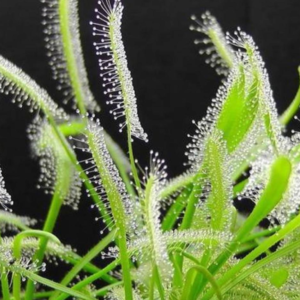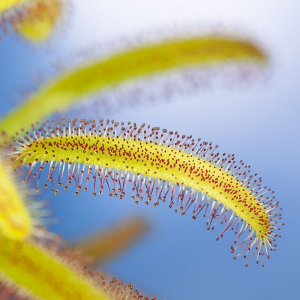We stock a number of drosera rotundifolia plants and round leaved sundews in our store you will find drosera rotundifolia plants 30cm along with drosera rotundifolia seeds.
Shop Drosera Rotundifolia (Round-leaved sundew) Online
-
 Drosera Capensis Alba – 7.5cm£6.00
Drosera Capensis Alba – 7.5cm£6.00 -
 Cape Sundew – 9cm£11.00
Cape Sundew – 9cm£11.00
The Drosera Rotundifolia is another great carnivorous plant for outdoor growing. It is also known as the roundleaf (or round-leaved) sundew and the common sundew. It is the most widely found sundew plant globally (hence its referral as the “common” sundew) and gets its name from its round-looking leaves. Bright red tentacles extend from the leaf, and it flowers white or light pink during the summer.
The common sundew is an excellent choice if you’re looking to add a carnivorous plant to your garden. Like many of its species, the roundleaf sundew thrives in wet climates such as bogs, fens, and marshes. Therefore you will want to keep the soil of your Drosera Rotundifolia consistently and evenly moist. Plant in a bog garden or shallow pot with fifty percent peat moss and fifty percent horticultural sand.
The common sundew is a temperate drosera, meaning it requires a period of dormancy each year to stay alive. Therefore, it will naturally survive winter in most of the UK as an outdoor plant. However, if you are keeping it as a houseplant, you’ll want to ensure it spends the colder months of the year in a cooler environment, such as an unheated garage or greenhouse. It does not need to be kept as cold as an outdoor plant but will need to spend several months in temperatures between 4 and 12 degrees celsius.
Like all sundew plants, the roundleaf sundew does not require fertilization. Instead, it obtains nutrients from small insects – gnats, fruit flies, and occasionally house flies. Like many carnivorous plants, the Common Sundew is known as a flypaper plant. The prey is attracted to the minute, and sweet-smelling dew drops that form on the end of the plant’s tentacles. If you keep it outside, the Drosera should get all its food needs met without your assistance. However, if you choose to leave the sundew plant indoors, you will need to ensure that it is getting adequate nutrients either by trapping live insects or purchasing freeze-dried larvae and feeding them to the plant.
Common sundew plants prefer bright sun, but pay special attention if you grow your plant outdoors; the full sun can occasionally scorch the plant’s leaves. If you notice the plant starting to look burnt or brown, rather than bright orange and red, move the plant to a partially shaded location. You should gradually introduce the plant to outdoor sunlight if it lives inside for part of the year to avoid shocking the plant.